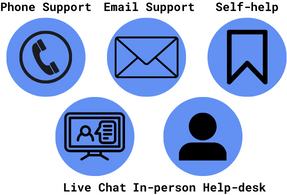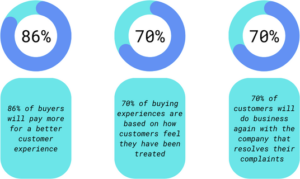- Industries
Industries
- Functions
Functions
- Insights
Insights
- Careers
Careers
- About Us
- Marketing & Advertising
- By Omega Team

Introduction
The customer service experience largely depends on how effectively we can solve our customers’ problems. This makes or breaks your relationship with your customers. As a result, we need to be careful and deliberate in our approach to customer service to avoid losing customers. Additionally, a company’s customer service experience is based on its interactions with a company’s sales, support, and service teams. Whenever a customer feels satisfied, they tend to return to a brand. That is the most surefire way to secure a customer, build loyalty and create a ground for repeat purchases, and to improve publicity. It is far more effective to retain a customer over a long-time than to keep acquiring new ones.
Figure 1: What makes the customer service experience?

Elements of Good Customer Service
There are four main elements that make good customer service experiences: reliability, availability, convenience, and personal communication.
Reliability. Reliability is a major factor that significantly impacts the customer’s experience. Reliability helps to build a company’s brand image and generate positive word of mouth. Reliability can vary depending on several factors, including the company’s commitment to customer satisfaction, the effectiveness of its processes and systems, and the competence and attitude of its customer service representatives. There are three main attributes of reliable customer service:
- Consistency: Reliable customer service involves providing consistent and dependable support to customers. This means ensuring that customers receive the same level of service quality and responsiveness across different channels and interactions.
- Accessibility: A reliable customer service experience is accessible to customers when they need assistance. This includes providing multiple channels for support, such as phone, email, live chat, or social media.
- Promptness: Reliability also encompasses promptness in resolving customer issues. Customers expect timely responses and resolutions to their problems or concerns. If a customer service team consistently takes too long to respond or resolve issues, it can undermine the reliability of the overall experience.
Availability. The availability of a customer service experience refers to the accessibility and responsiveness of customer service channels and representatives. There are two key ways to improve availability:
- Extended Hours: Availability also encompasses having customer service representatives available during extended hours. Companies that offer customer support outside regular business hours, including evenings, weekends, and holidays, cater to customers with diverse schedules and time zones.
- Response Time: The responsiveness of customer service is crucial for availability. Customers expect timely responses to their inquiries or issues, Companies should set clear expectations for response times and strive to meet those expectations consistently.
Convenience. The convenience of a customer service experience refers to how easy and user-friendly it is for customers to seek assistance and resolve their issues. A company’s customer service experience can be made more convenient by employing a user-friendly interface and prompt response times.
- User-Friendly Interface: The customer service interface should be intuitive and easy to navigate. This includes well-designed websites, clear menu options, and user-friendly self-service portals. A convenient experience minimizes the effort required for customers to find information or access the appropriate support channels.
- Prompt Response Times: Convenience is enhanced when customers receive prompt responses to their inquiries. Companies that prioritize quick response times and strive to resolve customer issues in a timely manner contribute to a convenient customer service experience
Personalized Communication. Personalized communication in customer service refers to tailoring interactions and messages to individual customers based on their preferences, history, and needs.
- Customer Data: Personalized communication relies on collecting and utilizing customer data effectively. This can include information such as customer preferences, purchase history, demographic details, and previous interactions with the company. By leveraging this data, customer service representatives can provide a more customized experience.
- Customized Messaging: Personalized communication involves crafting messages that are specific and relevant to each customer. Instead of generic responses, customer service representatives can use customer data to address the customer by name and to address the customer by name and reference specific details or past interactions. This helps create a more individualized and meaningful conversation.
- Targeted Recommendations: Customer service representatives can leverage customer data to provide targeted recommendations or solutions. By understanding a customer’s purchase history or preferences, representatives can suggest products or services that align with the customer’s interests, increasing the chances of a positive outcome.
Simplicity. The simplicity of customer service experience refers to how easy and straightforward it is for customers to navigate, understand, and resolve their issues.
- Clear and Intuitive Navigation: A simple customer service experience begins with clear and intuitive navigation. Websites, self-service portals, or mobile apps should have a well-organized structure with easily identifiable sections and menus. Customers should be able to find the information they need or access the appropriate support channels without confusion or frustration.
- Streamlined Processes: Simplifying customer service processes is crucial for a positive experience. Companies should minimize the steps required for customers to seek assistance or resolve issues. Complex and time-consuming processes can lead to customer frustration. Streamlining processes through automation, pre-filled forms, or guided workflows can significantly enhance simplicity.
- Self-Service Options: Providing self-service options simplifies the customer service experience by allowing customers to find solutions independently. This can include comprehensive FAQs, knowledge bases, or troubleshooting guides. Empowering customers to find answers to common questions or resolve basic issues on their own reduces the need for contacting customer service.
Importance of Customer Service Experience
Businesses cannot exist without its customers, which is why companies are focusing on how to build and get success in new business, and the more important thing is retaining existing customers. This helps to generate the lead for the company and the bring the new customers for the services which provides by the companies and the main importance is that is helps to build the connections and employees feels confident and it is of paramount importance for businesses across industries. It plays a crucial role in shaping customer satisfaction, loyalty, and overall brand perception.
Figure 2: Customer Service Experience Statistics.

Customer Satisfaction: Excellent customer service ensures that customers’ needs are met, and their problems are resolved effectively. When customers receive prompt, knowledgeable, and courteous assistance, they are more likely to be satisfied with their overall experience. Satisfied customers are more likely to become repeat customers and recommend the business to others.
Customer Loyalty: A positive customer service experience fosters loyalty. When customers feel valued and supported, they are more likely to remain loyal to the brand. Loyal customers tend to have a higher lifetime value, make repeat purchases, and become advocates for the business.
Brand Reputation: Customer service is a direct reflection of a company’s commitment to its customers. Providing exceptional customer service can enhance a brand’s reputation and differentiate it from competitors. Positive word-of-mouth recommendations and online reviews can significantly impact a brand’s image and attract new customers.
Impact of Poor Customer Service Experiences
Poor customer service experiences can have a significant impact on both customers and businesses.
- Negative Customer Perception: Poor customer service can leave customers feeling frustrated, angry, and dissatisfied. It can tarnish their perception of a brand and create a negative image in their minds.
- Decreased Customer Loyalty: Exceptional customer service is crucial for building customer loyalty. When customers receive poor service, they may lose trust in the brand and become less loyal. Loyal customers are more likely to make repeat purchases, provide positive reviews, and recommend the business to others.
5 Ways to Improve Customer Service Experiences
Personalization: Customize the customer experience by gathering relevant information about your customers and tailoring your products, services, and communications to their preferences. Use customer data to create personalized recommendations, offers, and targeted marketing campaigns.
Proactive Communication: Anticipate customer needs and reach out to them with relevant information and updates. This can include proactive notifications about order status, product recommendations based on their purchase history, or reminders about upcoming events or renewals. By being proactive, you can enhance convenience, save customers time, and show that you are attentive to their needs.
Enhance Communication Skills: Improving communication skills is crucial for providing excellent customer service. Train customer service representatives to actively listen to customers, ask clear and concise information. Encourage the use of positive language and ensure that representatives can effectively convey empathy and understanding.
Invest in Training and Development: Continuous training and development programs are essential for customer service representatives. Offer regular training sessions to enhance their product knowledge, problem-solving skills, and conflict resolution abilities. Provide opportunities for skill-building in areas such as communication, active listening, and handing difficult customers.
Streamline Processes and Reduce Response Times: Identify and eliminate any unnecessary steps or bottlenecks in your customer service processes. Streamlining procedures can help reduce response times and increase efficiency. Implement technology solutions such as customer relationship management (CRM) systems and chatbots to automate and expedite certain customer interactions. Ensure that customers can easily reach your support channels and receive timely responses.
Conclusion
Customer service experiences are dependent on the specific situation and the overall satisfaction of the customer. The most important factor in evaluating a customer service experience is the level of satisfaction achieved by the customer. If the customer’s issue was resolved efficiently and effectively, and they feel their needs were met, it can be considered a positive customer service experience.
Subscribe
Select topics and stay current with our latest insights
- Functions